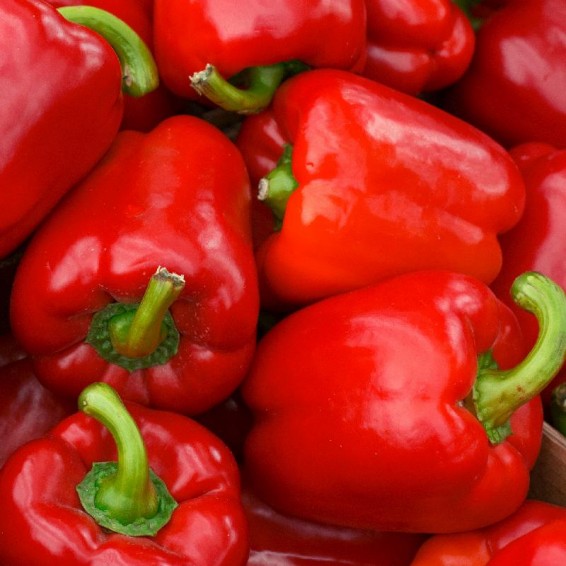Big Red Sweet Pepper Seeds
- HOW TO GROW
- FAST FACTS
- REVIEWS
HOW TO GROW
Sowing: Start big red sweet pepper seeds indoors in peat pots about 8 weeks before the last expected spring frost. Sow them 1/4" deep and keep the soil at 80-85 degrees F until germination; provide sunlight or a grow light for 12-16 hours a day. When the outdoor temperature reaches 60-65 degrees F during the day and no less than 50 degrees F at night, transplant the seedlings 12-16" apart. Exposing the plants to the weather for several hours a day before transplanting may help prevent shock. Peppers also grow well in containers or raised beds.
Growing: Keep the soil evenly moist and weeds under control; mulching the plants may help with this. If excess heat and sun cause the plants to wilt, provide shade.
Harvesting: Harvesting sweet peppers is basically a matter of personal preference regarding color and sweetness. Generally, the longer the peppers mature on the vine, the sweeter they will taste. Mature peppers, however, signal the plant to stop producing; if the peppers are picked when still at the green stage, the plant will go on producing. Always use a knife or scissors to remove peppers to prevent damage to the fragile stems.
Seed Saving: Keep in mind that peppers will cross pollinate with other varieties of pepper, so isolation or caging may be necessary to preserve genetic purity. Allow the pepper to fully mature, than cut it open and remove the seeds. Spread out Capsicum Annuum seeds to dry for about two weeks. Store big red sweet pepper seeds in a cool, dry place for up to two years.
FAST FACTS
Latin Name: Capsicum annuum
Type: Open Pollinated, Sweet Pepper, Warm Season
USDA Zones: 3, 4, 5, 6, 7, 8, 9, 10, 11, 12
Seeds per Ounce: 4,000
Planting Method: From Transplant
Sunlight: Full Sun
Height: 24 Inches
Color: Red
Big Red
Awesome Seller!
Big red pepper
Did not germ.
Sorry to hear! Let customer service know if you would like another packet to try or if you'd prefer a refund.
seeds
best seeds i ever bought
Not so big
I tested 8 different varieties of bell pepper seeds from the US and Europe for size plant hardiness and yield. In controlled conditions of a greenhouse they were planted 10" apart in rows spaced 3' apart. They were pruned to 2 stems and the stems were supported by strings hung from the ceiling wrapped around the stems. Seeds were direct sown in the soil. My experience was, while this variety produced, the fruits were so-so in today's environment. Great size for stuffing for individual servings. However, in this class of pepper, California Wonder is a better choice for fruit and plant size and strength.
DESCRIPTION
HOW TO GROW
Sowing: Start big red sweet pepper seeds indoors in peat pots about 8 weeks before the last expected spring frost. Sow them 1/4" deep and keep the soil at 80-85 degrees F until germination; provide sunlight or a grow light for 12-16 hours a day. When the outdoor temperature reaches 60-65 degrees F during the day and no less than 50 degrees F at night, transplant the seedlings 12-16" apart. Exposing the plants to the weather for several hours a day before transplanting may help prevent shock. Peppers also grow well in containers or raised beds.
Growing: Keep the soil evenly moist and weeds under control; mulching the plants may help with this. If excess heat and sun cause the plants to wilt, provide shade.
Harvesting: Harvesting sweet peppers is basically a matter of personal preference regarding color and sweetness. Generally, the longer the peppers mature on the vine, the sweeter they will taste. Mature peppers, however, signal the plant to stop producing; if the peppers are picked when still at the green stage, the plant will go on producing. Always use a knife or scissors to remove peppers to prevent damage to the fragile stems.
Seed Saving: Keep in mind that peppers will cross pollinate with other varieties of pepper, so isolation or caging may be necessary to preserve genetic purity. Allow the pepper to fully mature, than cut it open and remove the seeds. Spread out Capsicum Annuum seeds to dry for about two weeks. Store big red sweet pepper seeds in a cool, dry place for up to two years.
FAST FACTS
Latin Name: Capsicum annuum
Type: Open Pollinated, Sweet Pepper, Warm Season
USDA Zones: 3, 4, 5, 6, 7, 8, 9, 10, 11, 12
Seeds per Ounce: 4,000
Planting Method: From Transplant
Sunlight: Full Sun
Height: 24 Inches
Color: Red
Reviews
Review
Big Red
Awesome Seller!
Review
Big red pepper
Did not germ.
Sorry to hear! Let customer service know if you would like another packet to try or if you'd prefer a refund.
Review
seeds
best seeds i ever bought
Review
Not so big
I tested 8 different varieties of bell pepper seeds from the US and Europe for size plant hardiness and yield. In controlled conditions of a greenhouse they were planted 10" apart in rows spaced 3' apart. They were pruned to 2 stems and the stems were supported by strings hung from the ceiling wrapped around the stems. Seeds were direct sown in the soil. My experience was, while this variety produced, the fruits were so-so in today's environment. Great size for stuffing for individual servings. However, in this class of pepper, California Wonder is a better choice for fruit and plant size and strength.





